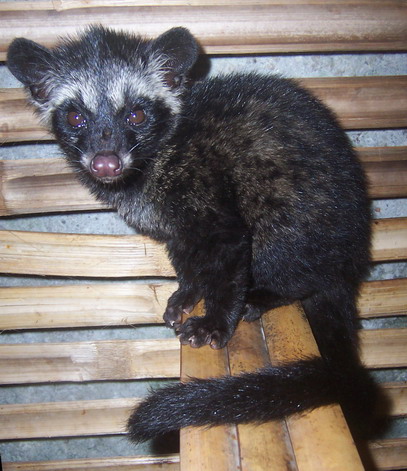|
| Query: viverridae | Result: 83rd of 84 | |
Asian Palm Civet (Paradoxurus hermaphroditus) - Wiki
| Subject: | Asian Palm Civet (Paradoxurus hermaphroditus) - Wiki
| |

| Resolution: 407x471
File Size: 81030 Bytes
Date: 2006:09:24 07:35:53
Camera: KODAK DX6340 ZOOM DIGITAL CAMERA (EASTMAN KODAK COMPANY)
F number: f/2.8
Exposure: 1/60 sec
Focal Length: 56/10
Upload Date: 2007:10:28 16:18:08
|
Asian Palm Civet
From Wikipedia, the free encyclopedia
[Photo] Asian Palm Civet (Paradoxurus hermaphroditus), juvenile, taken at Situgede, Bogor, Indonesia. Date 24 September 2006. Author W. Djatmi Copyright (C) 2006 W. Djatmi
Permission is granted to copy, distribute and/or modify this document under the terms of the GNU Free Documentation License, Version 1.2 or any later version published by the Free Software Foundation; with no Invariant Sections, no Front-Cover Texts, and no Back-Cover Texts. A copy of the license is included in the section entitled "GNU Free Documentation License". |
The Asian Palm Civet (Paradoxurus hermaphroditus), also known as the Common Palm Civet or the Toddy Cat, is a cat-sized mammal in the family Viverridae native to south-east Asia and southern China.
The Asian Palm Civet averages 3.2 kg (7 lb), has a body length of 53 cm (21 in) and a tail length of 48 cm (19 in). Its long, stocky body is covered with coarse, shaggy hair that is usually a greyish color, with black on its feet, ears and muzzle. It has three rows of black markings on its body. The markings on its face resemble a raccoon's. Its tail does not have rings, unlike similar palm civet species.
The Asian Palm Civet is a nocturnal omnivore. Ecological, they are frequently compared to as filling a similar niche in Asia that the Common Raccoon fills in North America. Its primary food source is fruit such as chiku, mango, and rambutan. It also has a fondness for palm flower sap which, when fermented, becomes toddy, a sweet liquor. It inhabits forests, parks and suburban gardens with mature fruit trees, fig trees and undisturbed vegetation. Its species name comes from the fact that both sexes have scent glands underneath the tail that resemble testicles. It can spray a noxious secretion from these glands. Its sharp claws allow it to climb trees and house gutters.
The SARS virus may have entered the human population from palm civets captured in the wild and improperly prepared for human consumption.
In Sri Lanka, the palm civet is known as "Uguduwa" by the Sinhala speaking community. In most parts of the island, Uguduwa becomes a menace to the people due to fact that it litters in ceilings and attics of common households, and then makes loud noises at night disturbing the sleep of the inhabitants of the house (noises are mostly due to their movements and fights).
The oil extracted from small pieces of the meat kept in linseed oil in a closed earthen pot and regularly sunned is used indigenously as a cure for scabies.
Kopi Luwak is coffee that is prepared using coffee cherries that have been eaten by the animal, partially digested, and harvested from its feces.
This species lives in a habitat that is fast diminishing.
Subspecies
There are a significant number of subspecies of this civet:
P. h. balicus
P. h. bondar
P. h. canescens
P. h. canus
P. h. cochinensis
P. h. dongfangensis
P. h. enganus
P. h. exitus
P. h. hermaphroditus
P. h. javanica
P. h. kangeanus
P. h. laotum
P. h. lignicolor
P. h. milleri
P. h. minor
P. h. musanga
P. h. nictitans
P. h. pallasii
P. h. pallens
P. h. parvus
P. h. philippinensis
P. h. pugnax
P. h. pulcher
P. h. sacer
P. h. scindiae
P. h. senex
P. h. setosus
P. h. simplex
P. h. sumbanus
P. h. vellerosus
http://en.wikipedia.org/wiki/Asian_Palm_Civet
| The text in this page is based on the copyrighted Wikipedia article shown in above URL. It is used under the GNU Free Documentation License. You may redistribute it, verbatim or modified, providing that you comply with the terms of the GFDL. |
|
Comments |
|---|
| | Samuel |
|
| 2GExNU Hello! I'm Samuel Smith, i'm from Switqerland i and find your site really brilliant! |
| | 27227 |
|
| comment4, |
| | 31138 |
|
| comment2, |
| | 47499 |
|
| comment1, |
| | name |
|
| comment4, |
| | name |
|
| comment3, |
| | name |
|
| comment3, |
| | name |
|
| comment1, |
| | name |
|
| comment1, |
| | name |
|
| comment4, |
| | name |
|
| comment2, |
| | ´ţÝţ ŃÓŰňň 10729 |
|
| comment4, |
| | ´ţÝţ ŃÓŰňň 10729 |
|
| comment5, |
| | ´ţÝţ ŃÓŰňň 10729 |
|
| comment5, |
| | ´ţÝţ ŃÓŰňň 19953 |
|
| comment5, |
| | ´ţÝţ ŃÓŰňň 19953 |
|
| comment6, |
| | ´ţÝţ ŃÓŰňň 19953 |
|
| comment6, |
| | ´ţÝţ ŃÓŰňň 24919 |
|
| comment6, |
| | ´ţÝţ ŃÓŰňň 24919 |
|
| comment4, |
| | ´ţÝţ ŃÓŰňň 24919 |
|
| comment4, |
| | ´ţÝţ ŃÓŰňň 29145 |
|
| comment6, |
| | ´ţÝţ ŃÓŰňň 29145 |
|
| comment5, |
| | ´ţÝţ ŃÓŰňň 29145 |
|
| comment3, |
| | ´ţÝţ ŃÓŰňň 29145 |
|
| comment3, |
| | ´ţÝţ ŃÓŰňň 24034 |
|
| comment4, |
| | ´ţÝţ ŃÓŰňň 24034 |
|
| comment1, |
| | Guest |
|
Scientific Name: Paradoxurus hermaphroditus (Pallas, 1777)
Common Names: Common Palm Civet, Asian Palm Civet, Mentawai Palm Civet
Synonyms:
Paradoxurus lignicolor Miller, 1903
Paradoxurus musangus (Raffles, 1821)
Paradoxurus philippinensis Jourdan, 1837
Viverra hermaphrodita Pallas, 1777 |
^o^
Animal Pictures Archive for smart phones
^o^
|
|
|

